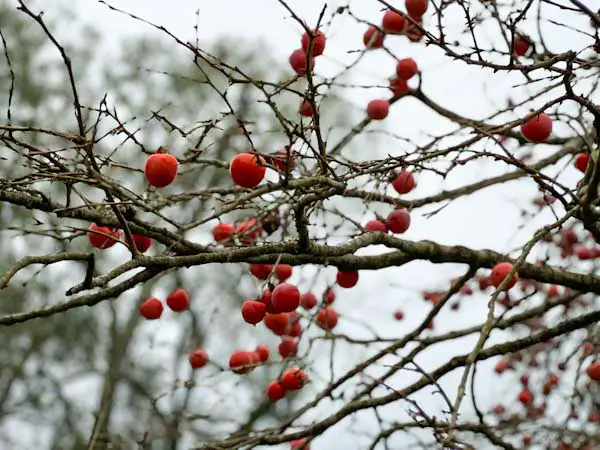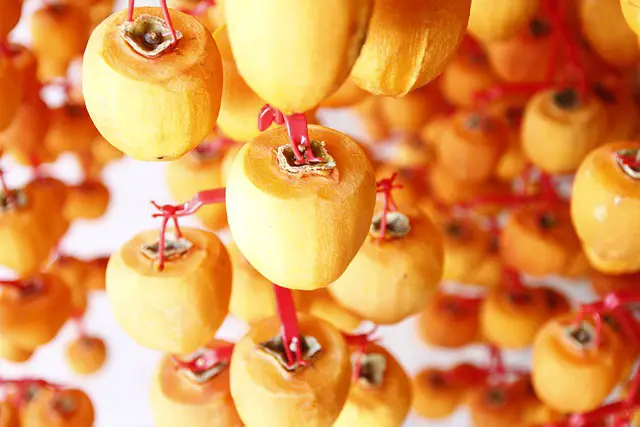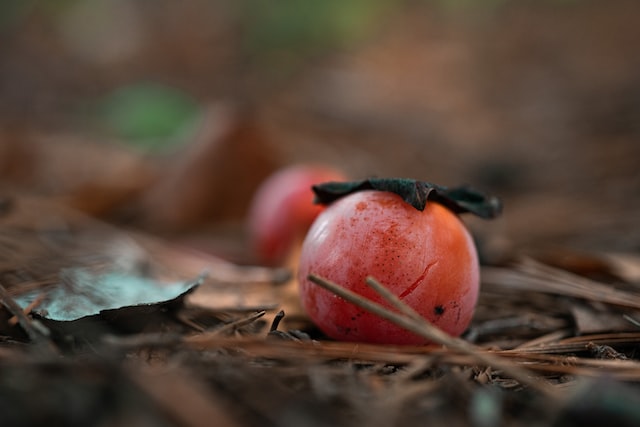
One of the joys and struggles I have in gardening is deciding exactly what varieties of plants to grow. As soon as I learned that persimmons grow well in my area, I knew I had to have at least one tree. But the decision-making didn’t stop there. Before I even got to choosing the cultivar, I first had to decide – do I want an American or Asian persimmon tree?
I live in the southern U.S., where American persimmons grow wild, but I’ve noticed that my local nursery mainly sells Asian varieties. So is one type better than the other? What’s the difference between American and Asian persimmons?
Asian (Diospyros kaki) and American (Diospyros virginiana) persimmons differ in size, native range, cold hardiness, and flavor. American persimmons are astringent when unripe but very sweet and soft when ripe. Asian persimmons can be either non-astringent (sweet but firm when ripe) or astringent.
There’s a lot more to these two types of persimmons than just flavor. In this article, I’ll dive into the similarities and differences between Asian and American persimmons. Perhaps by the end, you’ll come to the same conclusion I did – that no garden is complete without both.
History and Culture
Both the Asian and American persimmon hold an important place in their respective cultures. Their shared genus, Diospyros, comes from the Greek words diós and pyrós, literally meaning “Zeus’s wheat,” or “divine food.”
American persimmon
Diospyros virginiana, the American persimmon, is native to the eastern and south-central United States. (If you divide a map of the US into fourths, the lower right quadrant is its native range.) The English word “persimmon” was derived phonetically from the Algonquin word “putchamin” or “pushemin,” meaning “choke fruit” – a reference to the fruit’s astringency when unripe.

The explorer Fernando de Soto wrote about his discovery of these trees on his expedition to North America in 1538. Later, in the 17th century, persimmon trees were propagated and brought to Europe for the first time.
According to folklore, one can predict the severity of upcoming winter weather by observing the shape inside the seeds of an American persimmon. Cut the seed in half – if it is in a spoon shape, expect lots of heavy, wet snow; fork-like seeds forecast light, powdery flurries; and a knife shape means icy and bitter winds.
Other common names for the American persimmon include: wild persimmon, native persimmon, eastern persimmon, common persimmon, date plum, possumwood, Jove’s fruit, possum apples, or winter plum.
Asian persimmon
Diospyros kaki, the Asian persimmon, has been in cultivation in China for more than 2000 years, although it may have been in existence for as long as 10,000 years (read more here). It was introduced to Japan in the 7th century, and later to Korea and other Asian countries.
The kaki persimmon was brought to North America by Commodore Matthew Perry in the 1850s, and is now a common cultivated fruit, especially in California.
The persimmon has taken on enormous cultural significance in Japan, where it is a symbol of good luck, longevity, and transformation. It is used especially in New Year’s celebrations, both for food and decoration, to represent the promise of good health and success in the new year.

Japanese poetry, paintings, and ceramics are full of persimmon imagery. Since they ripen in the fall, persimmons are associated with seasonal change and fleetingness. Persimmons are used as a “season word” (kigo) in many haiku poems, including this famous one by Masaoka Shiki:
Biting into a persimmon The great bell tolls -Horyuji Temple
In this poem, the persimmon’s fleeting ripeness is contrasted with the longevity of the Horyuji Temple, the oldest wooden building in the world.
Other names for the Asian persimmon include: Oriental persimmon, Japanese persimmon, Chinese persimmon, and kaki persimmon.
What Do They Look Like?
Asian persimmons
Asian persimmon trees generally grow to be 12 to 30 feet tall and 15 to 25 feet wide if left unpruned. They naturally form a wide, rounded shape. (To read more about persimmon tree size and how to keep your tree more compact, check out How Big Does a Persimmon Tree Grow?)
The leaves are dark green with lighter undersides and are wide but slightly pointed. Asian persimmons have beautiful orange-red fall foliage, but when the leaves drop, the bright fruits remain on the bare tree and hang like ornaments until harvested.
The fruits are about the size of an apple or large tomato, depending on variety. ‘Fuyu’ is a bright orange, round, but slightly squatty (kind of like the shape of a pumpkin) persimmon with light orange flesh. ‘Hachiya’, another popular variety to grow, is deep orange and is more of an elongated, acorn-like shape.

The large fruits often cause the branches of an Asian persimmon tree to bow down, giving the tree a “weeping” look. Fruit thinning can help lighten the heavy load, and can also help each persimmon to grow larger and sweeter.
American persimmons
American persimmon trees grow to be much larger than Asian varieties, about 30 to 70 feet tall and 25 to 30 feet wide. They have grayish-brown, scaly bark, and deep green oval-shaped leaves. Like Asian varieties, American persimmons have beautiful fall foliage, ranging from yellow to orange to red.
The fruits from American persimmon trees are smaller than Asian persimmons, about the size of an apricot or plum. They typically fall from the tree when fully mature, which is good news because of the height of the tree. American persimmons range in color from tawny gold, to orange-red, to even somewhat blue-purple.
Growing Conditions
Both types of persimmons adapt well to different soil types but prefer well-drained, sandy loam in full sun. Slightly acidic soil with a pH between 6.0 and 7.0 is ideal. Another plus for both Asian and American persimmons is that they are rarely plagued by disease (check out Why Grow a Persimmon Tree? Here’s 10 Great Reasons if you need further convincing to plant one!).
There are a few differences in their growing needs, however. Read on to see what you need to know about growing American vs. Asian persimmons.
Growing American Persimmons
The most notable thing about growing the native American persimmon is its cold hardiness. These trees can be grown as far north as USDA zone 4 and can tolerate as low as -30° F.

Pollination is typically necessary for D. virginiana to produce fruit, which means the persimmons will be seeded. Most American persimmons are dioecious, in that a tree has either male or female blossoms, rarely both. Pollen from a nearby male tree is needed to fertilize the flowers of a fruit-bearing female tree.
Read Persimmon Tree Pollination: Do You Need Two Trees? to learn all about how different persimmons produce fruit. If you want your American persimmon to produce fruit, chances are you’ll need both a male and female tree (and therefore lots of space).
Growing Asian Persimmons
Asian persimmons thrive in a milder climate (typically USDA zone 7-10). They can tolerate cold down to 0° F when fully dormant, although temperatures at only 26° F will kill any leaves and active growth still on the tree.
It’s important to note that Asian persimmons break dormancy based on heat units, as opposed to chill hours. This means that spring growth can be triggered by unseasonably warm winter weather, leaving the tree susceptible to frost damage. In areas with cooler springs, the tree may not break dormancy until nearly summertime.
Most (if not all) Asian persimmon varieties are parthenocarpic, meaning the blossoms do not need to be pollinated to produce fruit. Unpollinated fruits will be seedless when mature. If pollination occurs, however, the fruits of some cultivars could change somewhat in texture and flavor (such as with the variety ‘Chocolate’), a characteristic called pollination-variant.
Which is Sweeter?
American persimmons often have a higher sugar content than Asian persimmons, although both are considered very sweet fruits when completely ripe. The real distinction of sweetness is not whether the persimmon is American or Asian, but whether it is an astringent or non-astringent type.

American persimmons are all astringent, meaning they must be completely soft and gelatinous before eating. If you bite into an under-ripe American persimmon, you will have an unforgettable (and very unpleasant) cotton-mouth experience. The astringency is due to the high concentration of tannins in the fruit, which decrease as the fruit softens over time.
Asian persimmons can be astringent (like ‘Hachiya’ and many others) or non-astringent (such as ‘Fuyu’ and ‘Ichikikei Jiro’). Non-astringent persimmons are still firm when fully ripe, ranging from a crisp texture to slightly soft and juicy like a peach. Read Astringent vs Non-Astringent Persimmons: What’s the Difference? to learn more about both types.
The flavor of astringent persimmons can be an acquired taste, although many prefer it for its complexity. A ripe astringent persimmon will have richer, more nuanced flavors, such as honey, apricot, rose, or even mild smokiness. Non-astringent persimmons have a milder, but still pronounced sweetness, like a pear, mango, or peach (without the “peachiness”).
Sweetness in fruit is measured by Brix, or the amount of soluble sugar present. Astringent persimmons have a brix of 20-24 (similar to wine grapes), and non-astringent persimmons have a brix of between 10-13 (closer to an apple), but the perception of sweetness may be even greater because of the persimmon’s lower acidity.
Which Persimmon is Best?
Now we come down to it – which is better, the American or the Asian persimmon? Unsurprisingly, it depends on a lot of things – what variety you choose, your taste and texture preferences, and what you plan to use the fruit for.

The key to getting the most flavor out of any persimmon is knowing when to harvest and eat the fruit. Check out this article to learn exactly when to pick different kinds of persimmons.
Uses for Asian persimmons
Dried Asian persimmons (called hoshigaki in Japan) are a delicacy in many Asian cultures. The fruits are peeled, hung in the open air, and massaged daily until a crystallized sugar coating is formed on the outside of the fruit.
The persimmon’s vitamin C is lost in the drying process, but the higher calorie content of a dried persimmon historically made it an important part of the winter diet, when less fresh food was available. Now, dried persimmons are enjoyed for their texture and extreme sweetness.
Hoshigaki is typically made with the ‘Hachiya’ variety, although any Asian persimmon can be delicious when dried. Just wait until the fruit is soft and juicy before drying, otherwise it could be to tough to chew.

Non-astringent Asian persimmons can be eaten raw straight from the tree, just like a crisp apple, or sliced and put in a salad. Once the flesh softens, as with astringent types, it can be used in jams, baked goods, or frozen for future use.
Other parts of the persimmon plant are also traditionally utilized in Japan. A liquid made from unripe fruit is used medicinally, in paper making, and as a wood stain. The leaves are full of vitamins and tannins and can be brewed as tea. They are also used to wrap certain foods in Japan, as the tannins have antibacterial properties. Persimmon wood is very hard and is used for furniture and housewares.
Uses for American persimmons
In colonial America, persimmons were brewed into wine and beer. Persimmon beer was particularly popular and was known as a “possum toddy.” Early Americans also recognized the potential medicinal qualities of the fruit, and persimmon concoctions became treatments for everything from dysentary to hemorrhoids.
In the civil war, persimmon seeds were used as buttons, particularly in the South. The war caused the South to have shortages of supplies and food items. Persimmon seeds were also roasted, ground, and brewed into a beverage that was apparently indistinguishable from regular coffee. (Note – I have not tried this so I cannot personally vouch for persimmon coffee!)

A ubiquitous southern American dessert is the “persimmon pudding,” a soft cake-pie hybrid made with pureed sweet persimmon flesh. The ripe fruit can also be used in breads, cookies, ice cream, and other desserts.
A ripe American persimmon (or astringent Asian variety) can be frozen and kept for months. Once frozen, a gooey ripe persimmon has a sorbet-like texture and can be eaten with a spoon for an easy treat.

